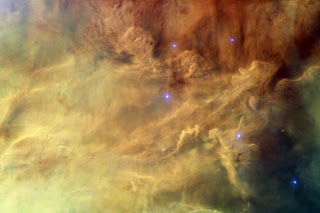Sunday, October 31, 2010
Halloween and the Ghost head nebula
Today is Hallowen! Halloween is a "cross- quarter" day, or a day halfway in between the equinox and the solstice.With a span of about 50 light years, this Ghost head nebula has earned its name from it's ghostly appearance and is said to look like Casper the friendly ghost. The "eyes" of this ghost are the two bright lights in the middle of the photograph. These formations are named A1 and A2. Within both A1 and A2 are large stars the green in the left of the picture is glowing oxygen. The glowing oxygen is produced by a strong stellar wind created by an enormous star that is not shown in the picture. The red and blue light shows the emitted hydrogen gas. It is located in the massive Megellanic cloud.
Friday, October 22, 2010
Prometheus rising through Saturn's F ring
In this picture is shown one of Saturn's 62 known moons. Saturn has 9 rings, named A,B,C,D,E,F and G(not in order from saturn) These rings are amazingly thin, being about only 100 meters thick, while they are thousands of kilometers wide. From a side view of saturn, the rings are seen as only a very thin line surrounding the planet. The F ring shown in this picture is held together by "shepard moons". Included in these mooons are Prometheus and Pandora. It is a very narrow and rather dim ring, but it has a diverse structure. This picture shows the trail of empty space created by the gravitaional force of Prometheus.
Friday, October 15, 2010
Christen Sorensen Longomontanus
Chritsen was born in the villiage of Lomborg in Jutland, Denmark. when he reached the age of eight, his father passed away. He studied at Lemvig until he was fourteen, when he then ran away to Viborg. He then started working so that he could provide for himself and started to attend the University of Copenhagen as well as grammar school. It was there that he met the well known Tycho Brahe. He became Tycho Brahe's valuable assistant. He left for three years to engage himself further in his studies, and then returned to Brahe. It was then that he assisted in developing the tychonic lunar theory. When he was done with this he went to Fraunberg and received his masters degree at Rostock. He became a professor at th University of Cophagen in 1607 and remained in this position until he died. Although Christen had his accomplishments, his beleifs were also very flawed. he saw comets as "evil" and went along with Brahe's theory regarding refraction. He also beleived that he had successfully "squared the circle."Squaring the circle was a problem that many ancient geometers tried in vain to find the solution to. This problem has been proven impossible today. He inaugrated the building of an astronomical tower. Christen was the true creator of is known as Brahe's geoheliogentric model. He created the Danish astronomy models in 1622. He also wrote a book entitled Astronomica Danica after the death of his master Tycho Brahe. In this book, Longomontanus integrated his observations and applied them to the motion of planets in the form of a "systematic treatise"
Sunday, October 10, 2010
Io in true coor
This strange moon is one of Jupiter's moons, discovered by Galileo. It is Jupiter's largest moon. It's surface is covered in continuously erupting volcanoes. Some of the lava bursting through it's surface has such a high temperature that it glows in the daark. The many volcanic eruptions on Io's surface is caused by the gravitational pull of Jupiter's surrounding moons as well as Jupiter itself, much like the tidal pull that we experience on Earth. It's surface consists of silicate rock and sulfur.
Hubble's lagoon
This is a close up picture of the lagoon nebula. This nebula spans 3 lightyears, and is also known as M8. It is located in the constellation Sagittarius. This nebula is especially interesting to me because it is one of the M objects I have been writing down on my constellation quizzes in class, but i never knew what the M object was I was writing down. In this region of the lagoon nebula, it is possible to see the high speed winds created by the formation of new stars.
Friday, October 8, 2010
Pacman and Hartley
In this picture is shown the Comet Hartley as well as the Pacman Nebula. The comet hartley can be seen on the right side of the picture, a blue-green color, and the pacman nebula can be seen on the left side. The comet Hartley was first viewed in 1968, with a magnitude of about 17. It's magnitude has grown increasingly higher since. It has been confirmed that it has a very small nucleus, with a diameter of only about .9 of a mile wide. Although it may be small, this nucleus spews gas and dust from it's surface. The comet is now closest to the Earth as it has ever been and was viewed on October 1st with a 4.4 magnitude. The comet will be the closest to Earth on October 20, with a distance of .12 astronomical units, where it can be seen South of Capella. The Pacman Nebula received its comical name from its appearance similar to that of a pacman. it is about 10,000 light years away, and has a span of about 80 light years.
Friday, October 1, 2010
Observation 9/30/10
Yesterday, as i was driving heading West, i saw Venus. I observed this at 7:45 PM and it was located fairly low in the sky, approximately 25 degrees above the horizon in the Southwest.
Subscribe to:
Comments (Atom)






